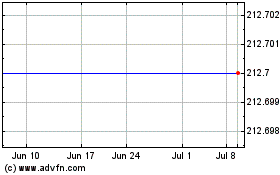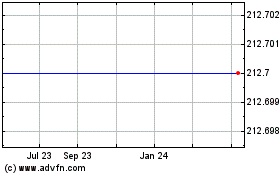UNH Increases Rev, Gains Members - Analyst Blog
January 19 2012 - 4:45AM
Zacks
UnitedHealth Group Inc. (UNH) has kicked off
the earnings today for the health insurance sector by reporting
fourth quarter earnings of $1.17 per share, substantially higher
than the Zacks Consensus estimate of $1.02. Earnings also compared
favorably with 94 cents per share reported in the prior-year
quarter.
The outperformance was driven by strong revenue growth from
UnitedHealthcare, as well as from the Optum businesses, partially
offset by higher medical cost.
For the full year, net income applicable to common stock was
$5.1 billion or $4.73 per share, up 15% year over year. Earnings
per share for full year also surpassed the Zacks Consensus Estimate
of $4.58 per share.
The largest publicly traded health insurer based on total
revenue posted total revenues of $25.9 billion, up 8.0% year over
year, and up 0.4% compared to the Zacks Consensus estimate of $25.8
billion. The increase was led by higher premiums and higher product
revenue in the health benefits business (UnitedHealth Care),
coupled with strong revenue growth from the service segment.
For the full year, revenue was $101.8 billion, up 8.1% from
$94.2 billion in 2010. This also compares favorably with the Zacks
Consensus Estimate of $101.7 billion.
UnitedHealth’s medical cost went up 7.9% year over year to $18.6
billion. Total operating cost increased 7.2% year over year to
$23.8 billion.
Segment performance
During the quarter, UnitedHealth’s health benefits segment named
UnitedHealthcare grew revenues 7.6% year over year to $24.2
billion.
The company’s other segment, Health Services branded as Optum,
witnessed a much higher growth of 23.4% year over year to $7.6
billion. The company is aggressively expanding this segment as a
means to diversify its earnings and expects to grow Optum to
contribute more than 30% of the earnings mix.
Membership Enrollment
The second-largest insurer after WellPoint Inc.
(WLP), based on enrollment, showed strong enrollment trends, as
membership grew sequentially across all major business lines.
Commercial risk enrollment came in at 9.55 million risk members up
1.5% year over and up 0.05% quarter over quarter. Meanwhile,
commercial fee-based enrollment was 16.3 million up 5.9% year over
year and up 0.4% quarter over quarter.
Commercial risk enrollment growth remained positive for the
seventh straight quarter, reflecting strong execution and
impressing in an economy plagued by continued high unemployment. It
is also to be noted that this is the fourth time in 12 quarters
that commercial risk enrollment has grown on a year-over-year
basis.
Medicaid grew 1.2% sequentially and 6.2% year over year,
and Medicare Advantage grew 1.1% sequentially and 8.2% year over
year.
Capital Position
UnitedHealth continues to maintain a healthy balance sheet,
ending the quarter with a debt-to-capital ratio of 29%. Days Sales
outstanding were 8 days, unchanged relative to the prior-year
quarter. Days claims payable (DCP) were 48 days, down 1 day year
over year, due to continued acceleration in the timing of claims
receipts.
Share Repurchases
Historically, repurchases and acquisitions have been one of the
most prevalent uses of capital for the company. During the year,
the company bought back close to 64.8 million shares at a total
cost of $3.0 billion.
2012 Guidance Affirmed
Management perceives an uptick in medical cost utilization in
the year. As such it has reiterated its revenue guidance range of
$107.0 billion to $108.0 billion and EPS guidance range of 4.55 to
$4.75 issued earlier during November.
Our Take
Overall, UnitedHealth managed to perform quite well in 2011, in
contrast to analyst predictions that the company’s earnings might
be under strain, given the challenges posed by the HealthCare law
and pressure on its government programs like Medicare and
Medicaid.
But the reform's impact on UnitedHealth’s business model and
operating fundamentals turned out to be quite manageable, albeit
still subject to uncertainty. The mandate regarding minimum MLR
that went into effect at the start of 2011 did not have a major
affect on the company’s bottom line. UnitedHealth was also able to
post better-than-expected results throughout 2011, attributable to
low medical claim costs.
In order to position itself for long-term growth, given the
Health Care Reform challenges, UnitedHealth continued to focus on
shifting more of its earnings to faster growing and less regulated
health-related service (non-insurance) businesses, with the goal of
ultimately making 30%-40% of operating income, up from about 20%
currently.
We expect the company to continue performing well in 2012. We
expect UnitedHealth to continue to benefit from gains in the
Medicaid and Medicare segments, fast growing health services
segment and a strong balance sheet.
UnitedHealth is a bellwether for the managed care sector and it
gives a glimpse of earnings performance of other players –
WellPoint, Cigna Corp. (CI) Aetna
Inc. (AET) and Humana Inc. (HUM) all of
which are due to release their earnings shortly.
AETNA INC-NEW (AET): Free Stock Analysis Report
CIGNA CORP (CI): Free Stock Analysis Report
HUMANA INC NEW (HUM): Free Stock Analysis Report
UNITEDHEALTH GP (UNH): Free Stock Analysis Report
WELLPOINT INC (WLP): Free Stock Analysis Report
To read this article on Zacks.com click here.
Aetna (NYSE:AET)
Historical Stock Chart
From Apr 2024 to May 2024

Aetna (NYSE:AET)
Historical Stock Chart
From May 2023 to May 2024
